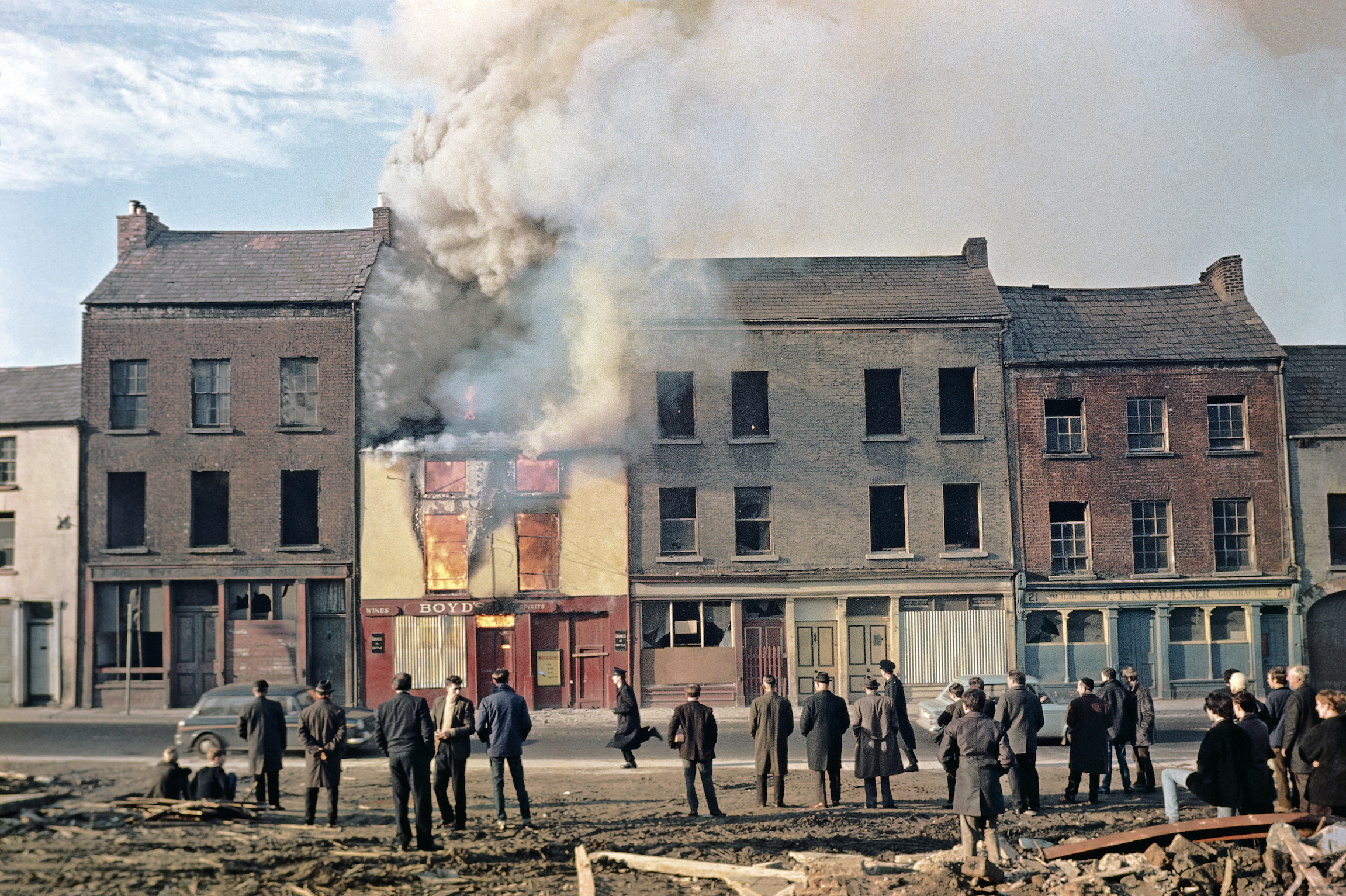All images © Estate of Akihiko Okamura
Akihiko Okamura photographed the Vietnam War before arriving in Ireland – and his view of the North’s sectarian violence was uniquely poetic
Akihiko Okamura’s photographs of the North of Ireland during the early part of the Troubles are subtle and resonant. There are no others quite like them. The Memories of Others, a beautifully presented show at Photo Museum Ireland, confirms the brilliance and exceptionality of this work by the Japanese photographer. The Dublin exhibition is the first substantial show of Okamura’s Irish work and includes previously unseen pictures, scanned and digitally printed from his Kodachromes, together with a photobook and a short documentary film.
Okamura’s vision is humanist and humanising – and it is the everyday and familiar in his pictures that condenses and communicates powerfully (but slowly) the impact of violence on people during the Troubles. The contents of homes are literally on the street as Okamura photographed the aftermath of Catholic neighbourhoods’ homes being burnt out by loyalists in West Belfast in 1969. In front of burnt-out red brick terraces, two women, their faces registering the daze and uncertainty of their loss of home, quietly come to terms with what little they have left. Colour helps pick out curious everyday details like the yellow box of Bird’s Custard Powder alongside a stack of best plates that have been salvaged. In making a still life from the riot gear of the RUC police on a street in Derry, the detail of a magazine, flask and plastic lunch box offers a humanising touch beside the black riot shield and visored helmet.
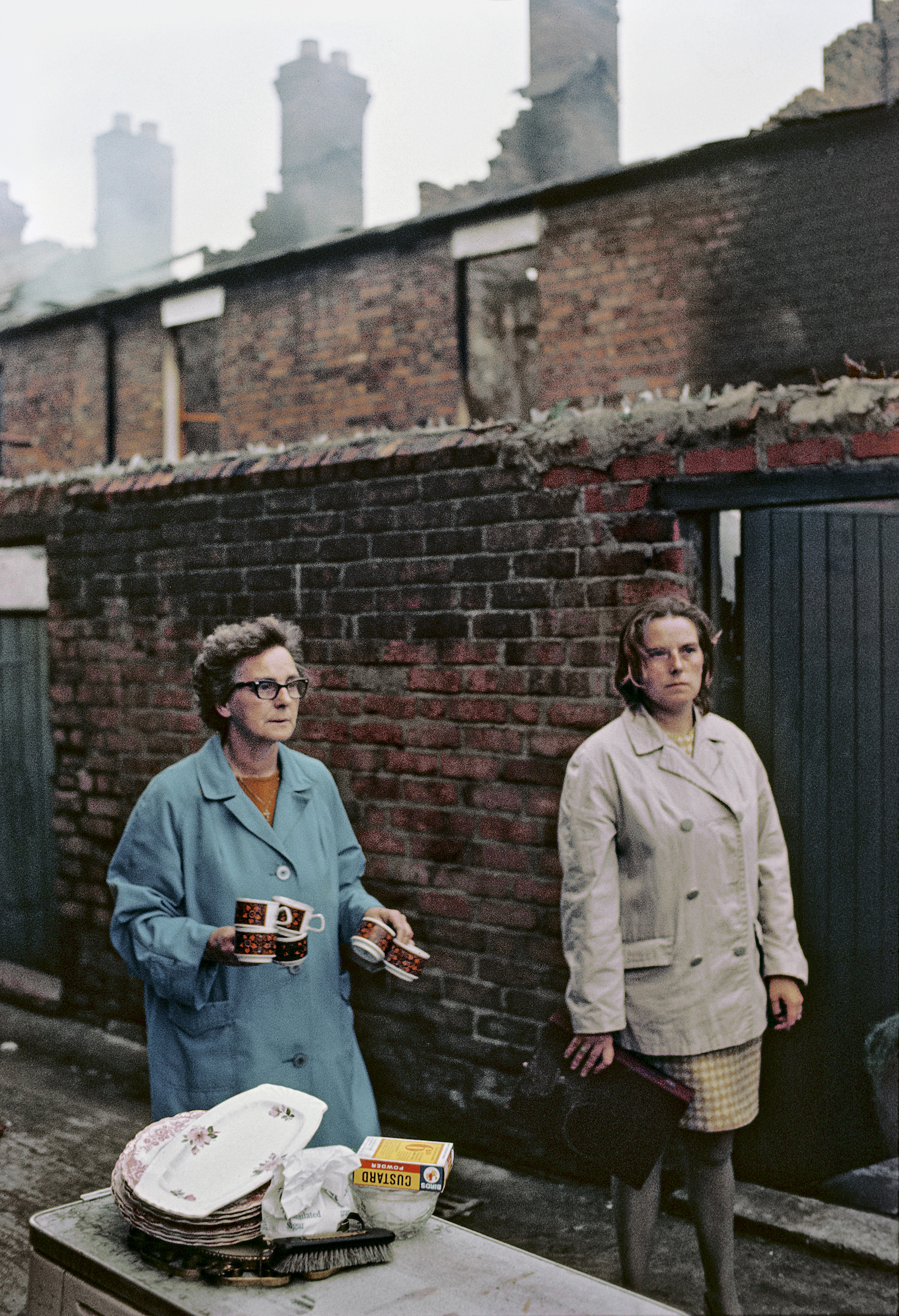
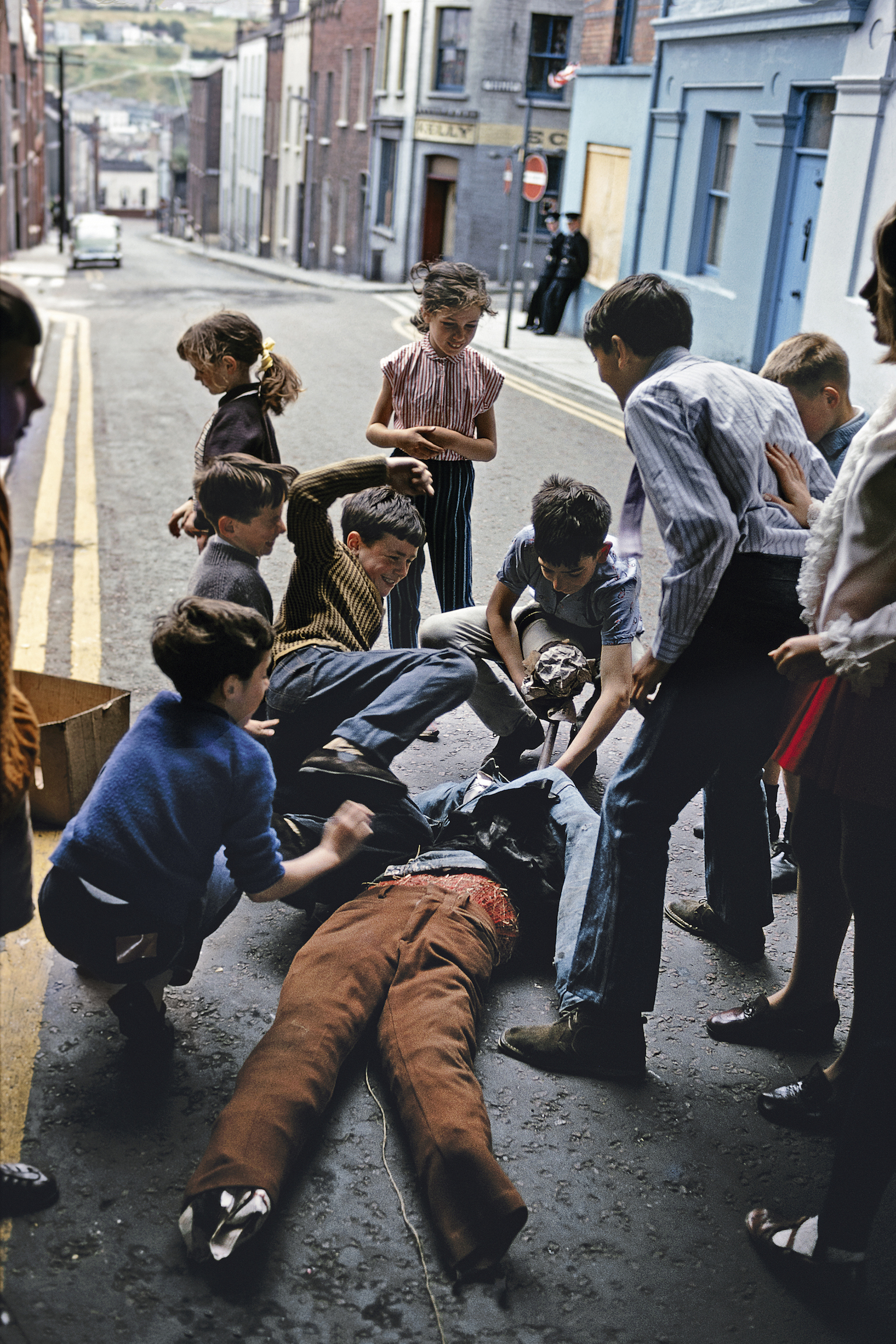
“It is the intimacy and tenderness of Okamura’s photographs that distinguishes them from both the exhortations of photojournalism, but also the art photography that followed”
In a picture taken at Bombay Street (also in West Belfast) a British soldier is shown carrying a door, while a woman, presumably its owner, walks beside him. The picture captures them as they stride in unison. He is helping her. It is a moment of care. But at the same time her head is down as she walks and the door comes between and separates them. On the door’s decorative glass window is the detail of a flying bird: a little visual joke about both the photograph’s own fixing a moment and, as one of the show’s co-curators Sean O’Hagan suggests, the woman’s flight from home.
In another picture showing civilians passing through a British Army barricade, one woman in particular appears to catch Okamura’s eye. The image is not so much about the violence of separation implied by the scrawl of barbed wire behind her, but gestures of help and support. Interactions between women and soldiers recur. In another picture a woman holds a magazine by a barricade and despite the visible screens between them, seems to be trying to communicate by reading something to a soldier, whose face is turned towards her but still behind his visor and riot shield.
Okamura has cited his childhood terror under Tokyo’s bombing in the Second World War – in which the family home was destroyed – as a source of motivation to become a war photographer. Born into an aristocratic family, he was renowned as a photographer in the first years of the Vietnam war, publishing in Life magazine in colour in the same 1964 issue as Larry Burrows. Okamura first went to Ireland in 1968 to explore John F. Kennedy’s ancestral roots. The following year he settled in Ireland, first near Dublin, then Avoca, in County Wicklow. The photo historian Pauline Vermare claims in the exhibition book that as an “anti-colonialist, socialist, or even anarchist, Okamura instinctively identified with the nationalist and republican cause, believing fundamentally in a united Ireland”.
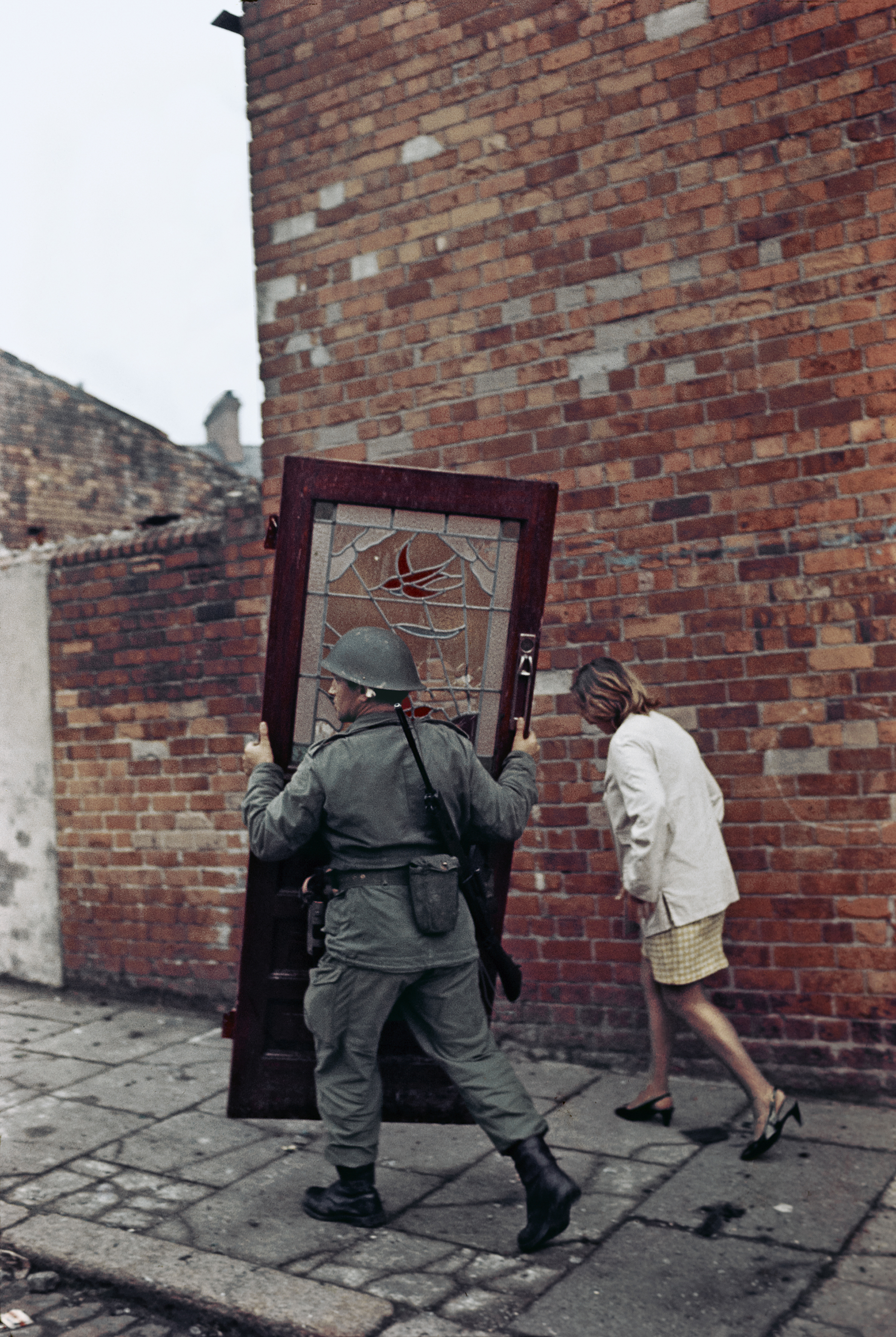
It is his openness to the surprising and strange which makes Okamura’s colour pictures so rich and engaging. A key image (which appears on the book’s cover) is of six full bottles of milk, one green top among five red. The meaning of these bottles is made clear when we see a photograph of emptied milk bottles alongside stones at Rossville Flats in Derry, ready for use as Molotov cocktails by nationalists in the riots known as the Battle of the Bogside – generally considered the beginning of the Troubles.
The picturing of milk demonstrates the movement of a common object, and the brilliant intelligence and poetic thinking in Okamura’s photographs. That simple change from full to empty bottles is an apt allegory for a loss of life and more, depletion – a draining of the milk of sustenance and human kindness. There is also an image of milk churns which, much as they can evoke a certain rural and pastoral vision of Ireland, might also not be so innocent. In January 1974, the IRA dropped explosives in milk churns on an RUC station in Strabane (they missed and didn’t explode); and in the following year, four British soldiers were killed by a bomb hidden in a milk churn in Belfast.
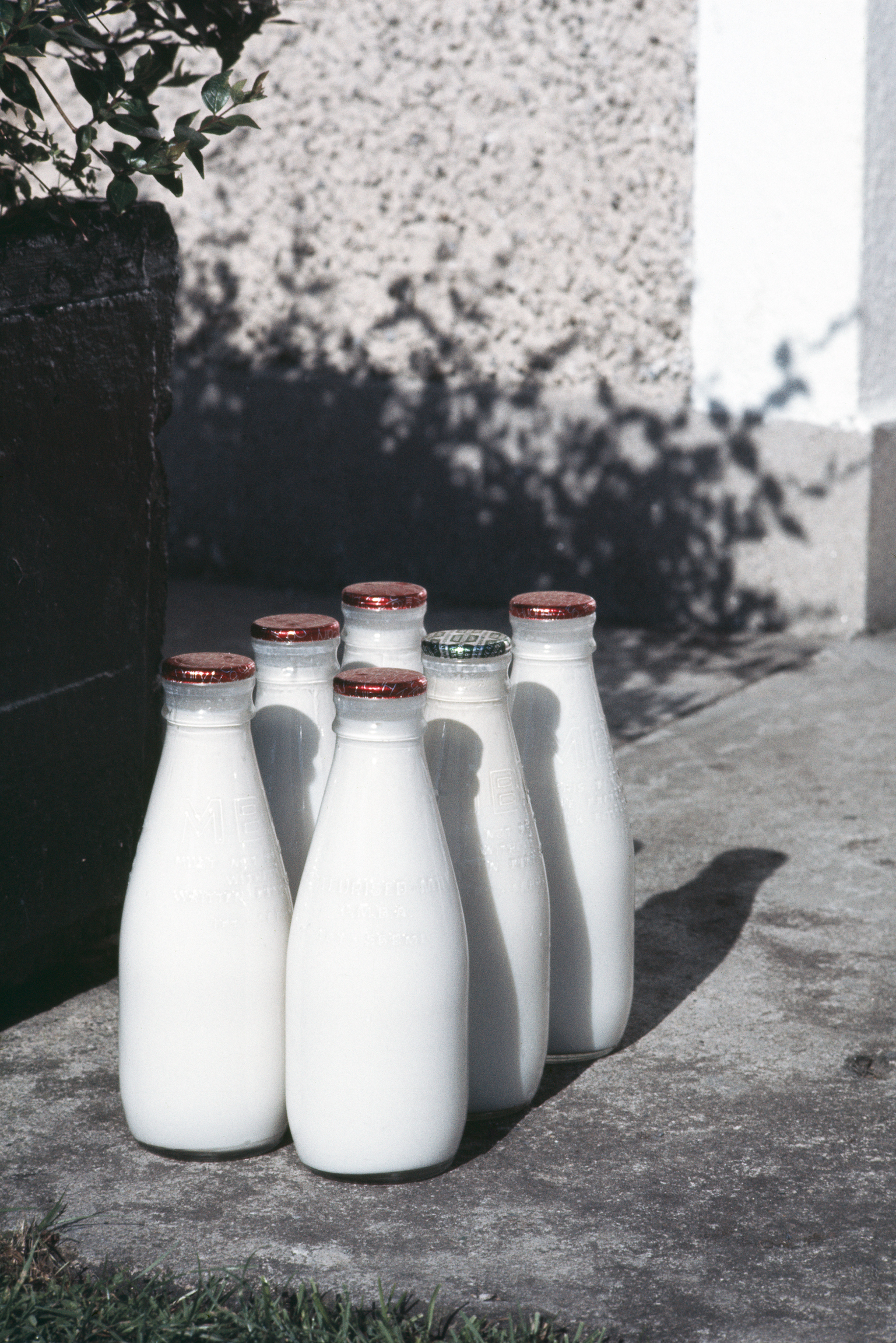
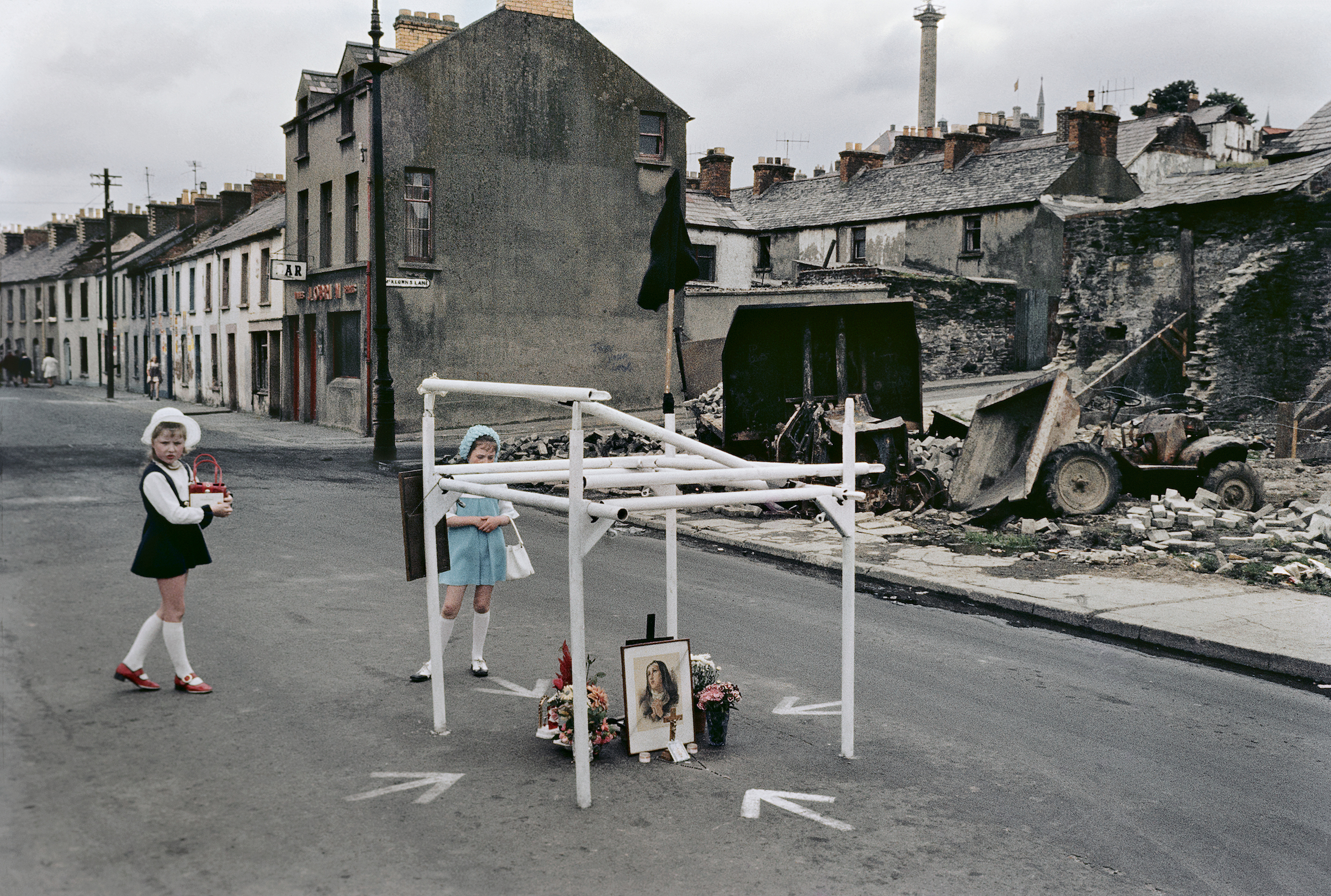
Conflict contemporaries
Okamura’s photographs are locked into a historical moment, but their aesthetic approach looks towards the more elliptic and poetic colour work of Paul Graham. The English photographer’s Troubled Land (1984-5) concentrates on the landscape of the conflict, a long and distanced view which combines the beauty and lushness of the Irish country with political slogans – a contested and divided land, a war zone. Graham’s approach was to de-dramatise through his photographic mode, to counteract the black-and-white photojournalism of the Troubles which naturally gravitated to dramatic events, spectacle and legibility.
Then there is Gilles Peress’ Whatever You Say, Say Nothing (2021), a useful contrast to both Graham’s and Okamura’s pictorial quietism. The French artist’s visceral and conceptual response to the conflict takes the form of a monumental two-volumed photobook which involved a subjective return to and reviewing of his black-and-white reportage. The process registered the impact of Peress’ own trauma in photographing and being shot at during the civil-rights demonstration that became known as Bloody Sunday, when the British Army shot and killed 13 unarmed civilians and seriously wounded 15 others (one of whom subsequently died). Whatever You Say also dealt with Peress’ longstanding friendship with Denis Donaldson, a key figure in the Republican movement, and the shock of his confession in 2005 that he had been under the pay of the British intelligence services since the mid-1980s. (Donaldson was murdered soon after this admission).
Peress’s pictures follow the pattern of dramatic photo-reportage, of being close to events on the ground. But he shifts away from journalistic convention, mixing the book with scanned transcripts of his testimony from the Bloody Sunday inquiries and magnified scans of his negatives. In trying to convey the shock of Donaldson’s confession, he includes stills from John Ford’s film about an Irish Republican’s act of betrayal, The Informer (1935), as well as family photographs, enlargements of news reports about his confession and murder, and Donaldson’s memorial funeral card. Whatever You Say is experimental, but is perhaps not really categorisable as art photography, rooted instead in the power of the documentary tradition. Yet there are some parallels with The Memories of Others in the way Peress is also alert to the contradictions and absurdities of the Troubles.
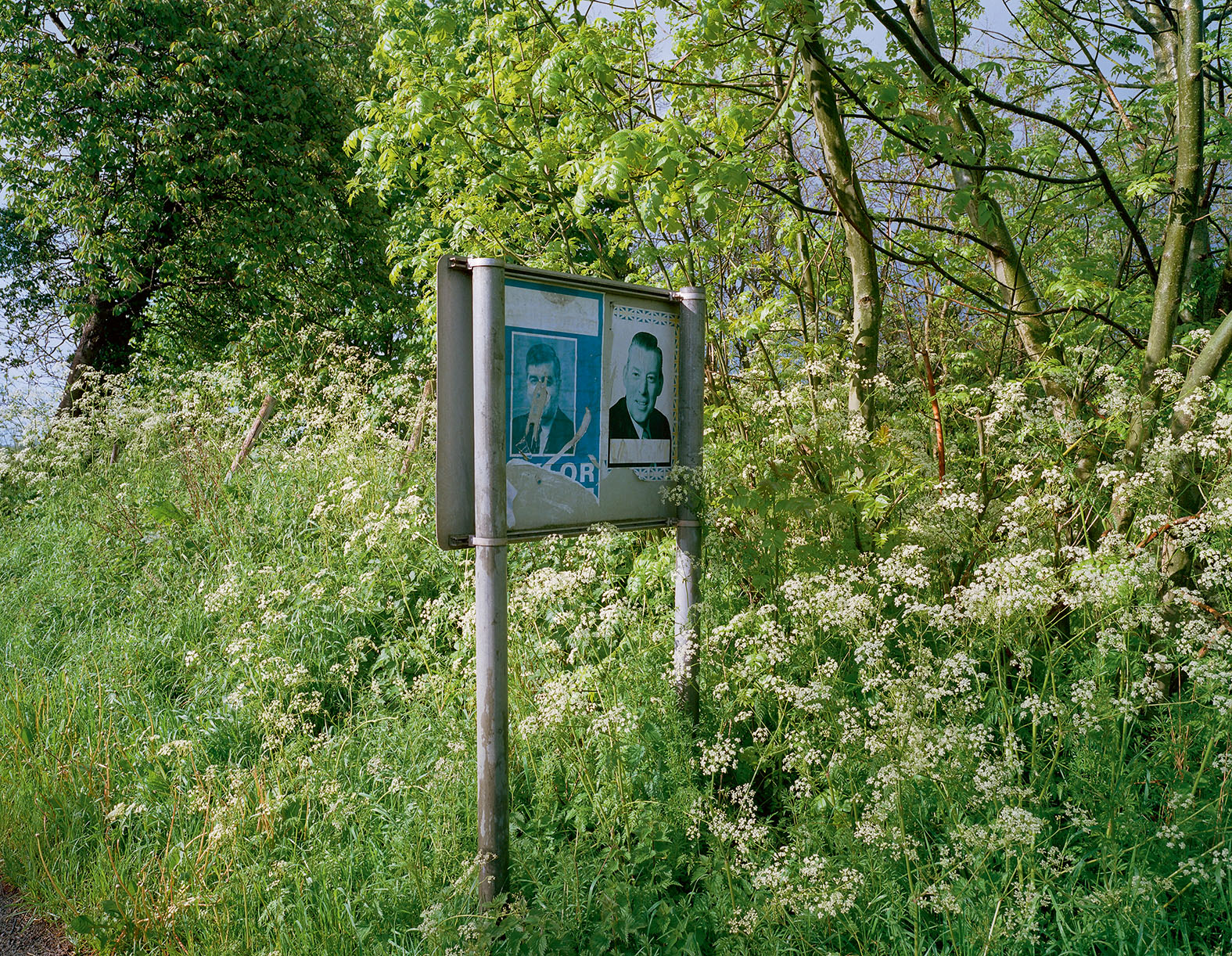
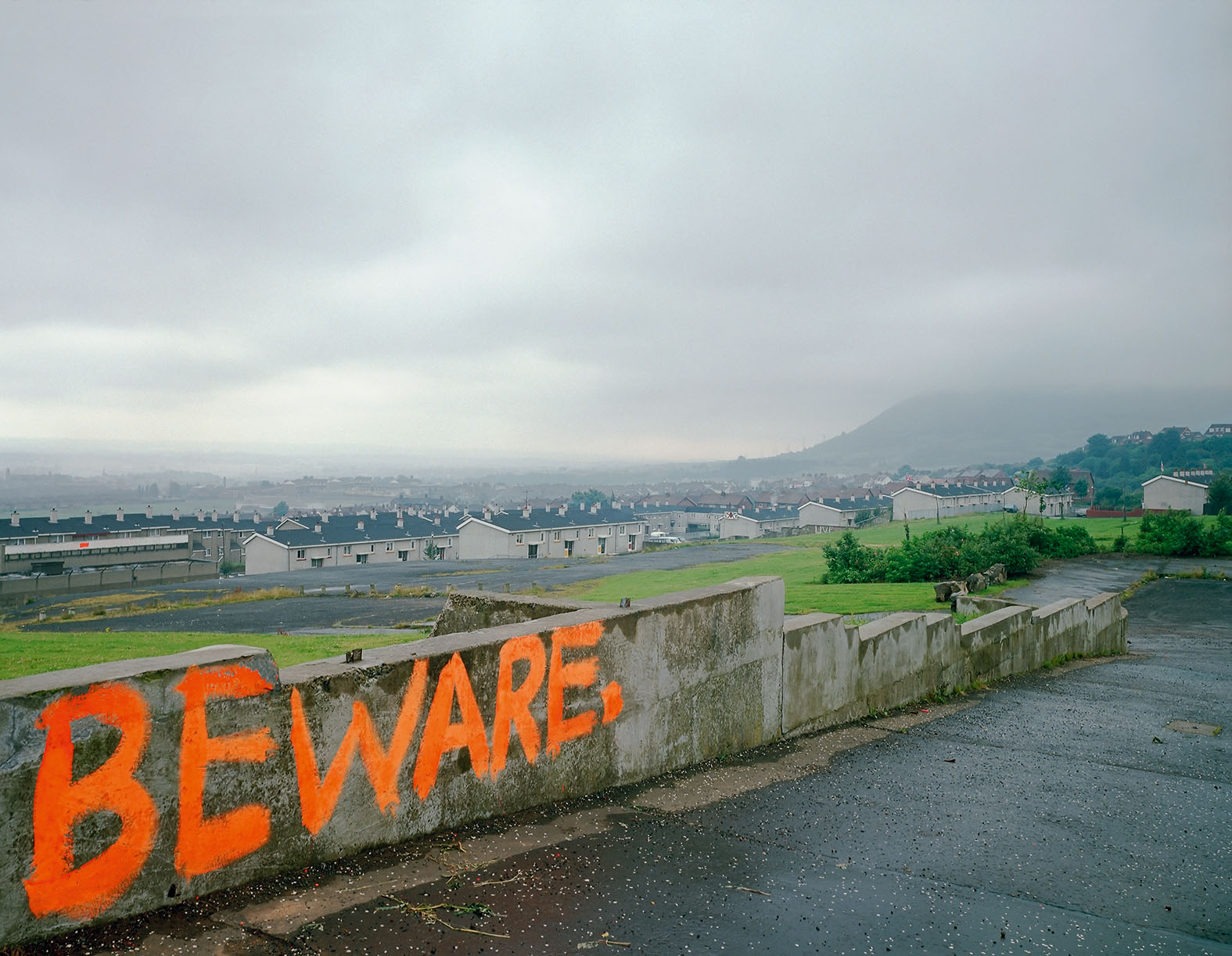
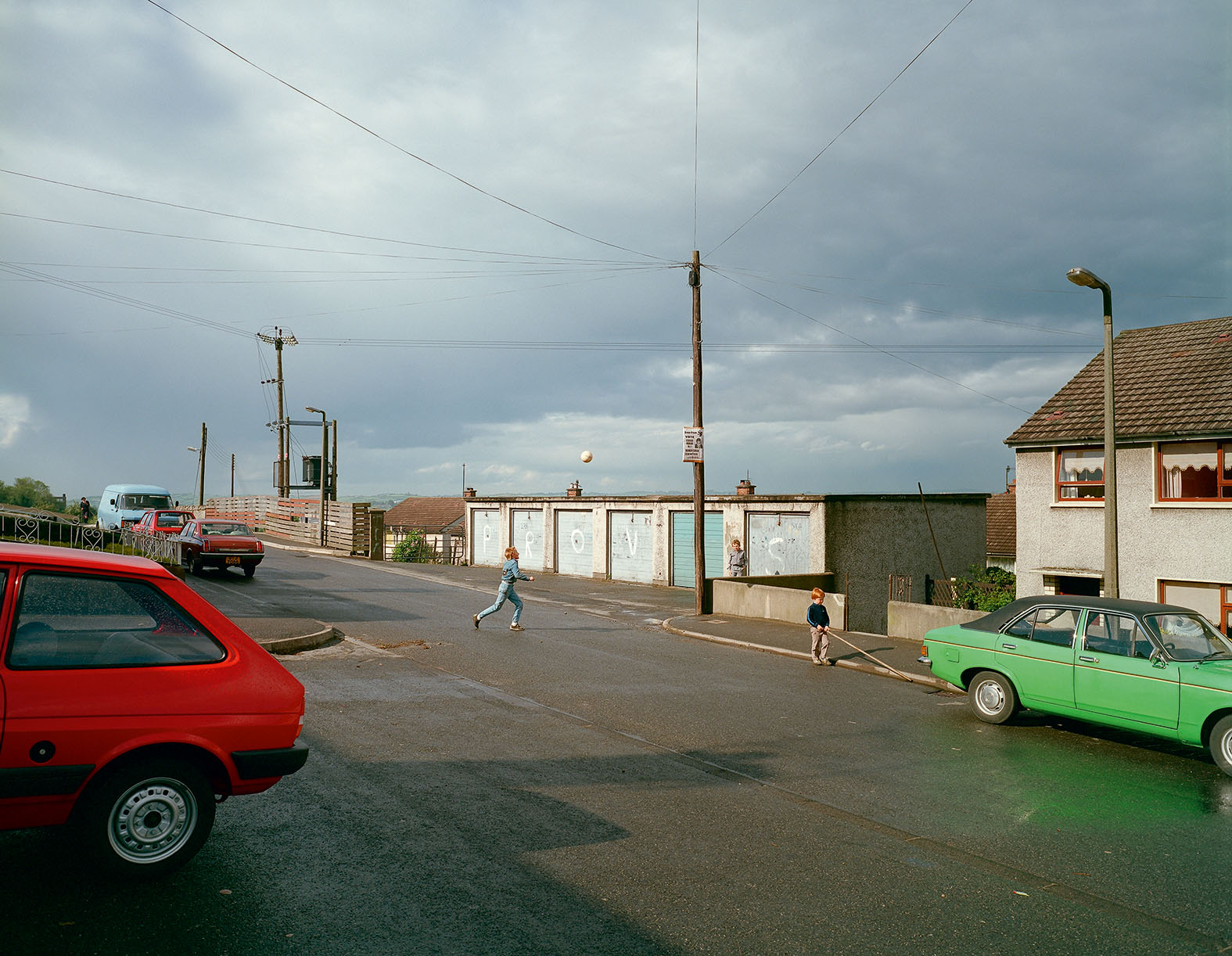
Okamura’s most direct pictures in relation to the violence show Derry street memorials where two people were killed by the British Army in 1972. One shows a black flag, flowers and a blood stain on the pavement. A man with a young child in one arm, and his other on the shoulder of a little boy beside him, stands by this temporary memorial. They appear to be posing to have their picture taken by two women – one the same age as the man and the other younger. One assumes it is a family gathering; Okamura pays his own respects by capturing this moment of self-documentation. The second photograph is a little more elaborate. A white scaffolding structure and a black flag mark the spot where the killing occurred. There are also flowers, crosses, rosary beads and pictures of the sorrowful Virgin Mary. Two young girls in Sunday dress are pictured visiting the memorial, children again unsheltered from these violent realities. Here we reflect on grief and loss, but without the dramatic theatre of the grieving. Peress takes us close to the emotion, sometimes painfully close. Okamura’s dealings with loss are quieter and understated, but no less moving for that.
It is the intimacy and tenderness of Okamura’s photographs that distinguishes them from both the exhortations of photojournalism, but also the art photography that followed. Much as Okamura’s colour photography might be seen to anticipate the undramatic and aesthetic approach of Paul Graham’s, his pictures are more nuanced in their poetic register of this conflict. In showing us Northern Ireland as a landscape of opposing signs, Graham’s work never escapes the binary of the divisions it shows us. Okamura gets closer and is interested in people, showing how violence saturates life at a micro level. Colour does not just play an aesthetic role, it helps bring out texture and context to lives which have been so violently disrupted. It is not a distraction, but a cue to pathos. And while Okamura’s identification with the Republican cause is clear, his affection for the people in Ireland goes beyond this.
Akihiko Okamura, The Memories of Others, curated by Pauline Vermare, Sean O’Hagan, Masako Toda, Trish Lambe and Brendan Maher, is at Photo Museum Ireland, Dublin, until 06 July; the photobook of the same name is available now (Atelier EXB, co-published in English by Prestel)

